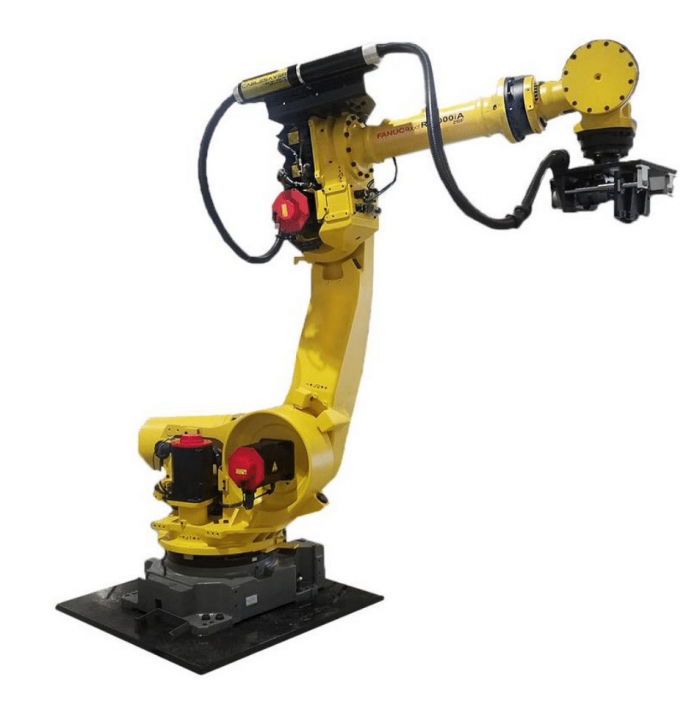Customer, Challenge & Risks
We were approached by a facility engineer for a leading worldwide provider of vacuum impregnation technology, x-ray equipment, and water treatment systems for automotive, aerospace, and industrial industries. The company began as a small business over 70 years ago and has grown to a global footprint with its HQ residing in Northeast Ohio. Our customer was handling a high-volume/high-value part for the automotive industry with a small margin for error.
Pioneer was faced with the requirement to increase the throughput of an existing robotic work cell to meet their customer’s needs and future growth. The only viable solution was to integrate an additional x-ray cabinet and robot into the current system. The risk of not increasing throughput could result in our customer not meeting the production demands of the contract agreement and being held liable for lost revenue. Challenges were to meet an aggressive installation schedule during a shutdown period, coordinating with other contractors working within a confined space, and determining ownership then solving any issues that came up during start-up.
Although this process was already automated when our customer reached out, this application lent itself as an ideal fit for industrial robots for many reasons. Manually handling the parts was not be feasible due to the overall size and weight. It was paramount for precise and consistent pick and placement of the parts, especially in and out of the x-ray cabinet. Since this was a repeatable, labor-intensive application, it was easily justifiable to automate for increased safety and revenue.
Solution
Pioneer was previously introduced to this customer through a partnered integrator, solely for robot programming. Our contact reached out since we were a familiar name and located within proximity to the facility. It was a benefit this facilities staff was well versed in robotics and automation and equipped with the resources to properly support the cell once in production.
Once we clearly defined the scope based on budget and specifications, we came to an agreement that provided the customer with the best solution and utilized multiple vendors. The customer was able to provide a used robot, which helped them with their budget constraints.
One of the obstacles presented was to reverse engineer an existing End of Arm Tool (EOAT). In the process, we created a 3D model for fabrication and assembly, which we provided the customer for their records.
We were able to provide our automation expertise to increase productivity through robot path programming and efficient process steps without drastically increasing the footprint of the total cell. Minimizing the x-ray cabinets downtime maximized the throughput of the cell, which was accomplished by incorporating two wait stations close to the opening of the x-ray cabinet. This staged parts while the x-ray machine performed its function, which eliminated the long robot movements to and from conveyors and x-ray cabinets.
Due to time and logistical constraints, we did not have a complete mod-build on our floor. This required us to work closely with the customer and other vendors to ensure everyone’s pieces worked together. After extensive testing with the robot and EOAT, we were confident in our portion.
The Pioneer team kept in close contact with the customer, updating progress and timeline throughout the project. Working closely with the customer and the other vendors, a plan was coordinated for the installation process. It was vital that we had personnel present during start-up to troubleshoot any issues since this was the first time the cell would be fully operational, and all the equipment integrated.
Due to the confined work cell space, we were required by RIA regulations to incorporate Fanuc DCS software that provides a safety redundancy envelope around the robot. DCS is a programmable safety net around the robot that does not allow the robot to move outside of those limitations. Since the customer elected to provide a used robot, this created a roadblock as we could not install DCS due to the series of controller. We quickly changed routes and used hard stops to keep the robot from extending beyond the required distance to the safety barrier. Although not an ideal solution, this fit within the budget and met safety requirements.
Outcomes of Success
The customer came to us with several challenges, including a tight budget and timeline along with safety and throughput requirements. We were able to ultimately provide a solution that increased overall productivity, efficiency, and safety. Our team completed this project on time and within the customer’s budget, bringing value to the customer through our core competencies of PLC and robot programming expertise. The success of the project initiated a growing relationship between Pioneer and the customer. In fact, this project was such a success that a duplicate system was installed within that same year at a different facility.

Automotive – Tier 1
General Industrial – Aerospace
Request a Free Consultation Call
Contact us today to talk to an automation expert about your unique challenges. We take the time to listen and will help you to assess your options. From there, we’ll set up a free consultation to visit your operation and see your challenges first hand. There is never an obligation. We are just passionate about helping manufacturers solve their problems with robotics and automation.





